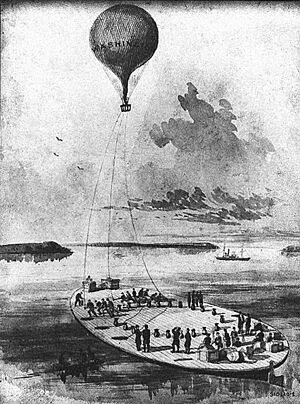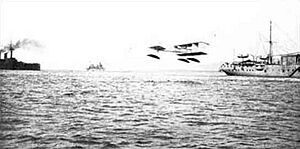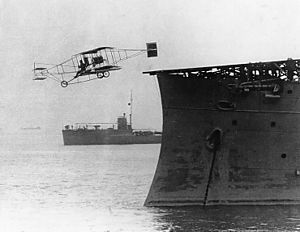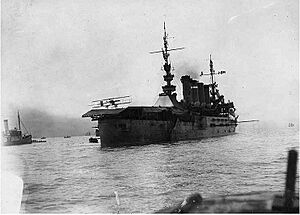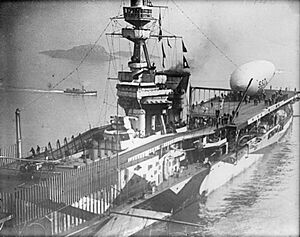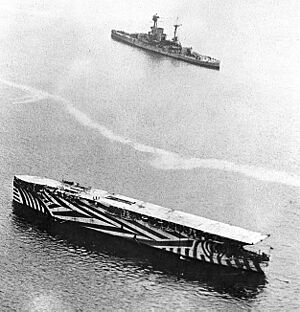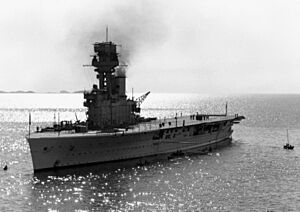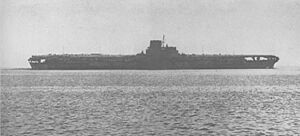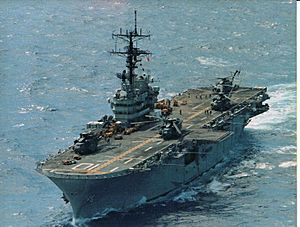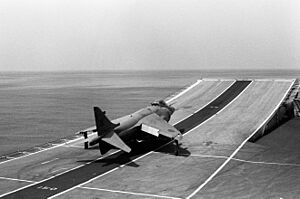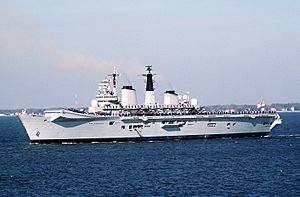History of the aircraft carrier facts for kids
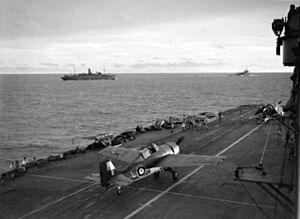
Aircraft carriers are huge warships that act like floating airfields. They carry many different types of airplanes and helicopters. These ships allow a country's navy to send its air power far across the oceans without needing airbases on land. This makes them super important for defending interests and helping allies around the world.
The idea of carriers started small, with ships carrying balloons. Then came ships for seaplanes. Over time, these ships grew into the powerful, nuclear-powered vessels we see today, which can carry dozens of aircraft.
Contents
How Carriers Began: Balloons and Seaplanes
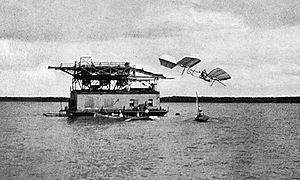
The very first time a ship was used for anything airborne was in 1806. A British Royal Navy ship, HMS Pallas, launched kites to drop leaflets over France!
Balloon Ships
Later, in 1849, an Austrian Navy ship, SMS Vulcano, tried launching hot air balloons with bombs over Venice. It didn't work very well because of the wind.
During the American Civil War (around 1861-1865), gas balloons were used for spying on enemy positions. A coal barge, USS George Washington Parke Custis, was turned into a balloon ship. From this barge, Professor Thaddeus S. C. Lowe made the first flights from a ship, sending messages by telegraph.
These early balloon ships led to "balloon tenders" in World War I. About ten were built by different navies, mainly for observation. After the war, most were taken out of service or changed into seaplane carriers.
Seaplane Ships
When seaplanes were invented in 1910, ships were soon designed to carry them. In December 1911, the French Navy's Foudre became the first ship designed as an aircraft carrier, though it only carried seaplanes. It had hangars and a crane to lift the seaplanes into the water. Later, it even got a flat deck for launching.
HMS Hermes was an early British experimental seaplane carrier in 1913. It was originally a merchant ship, then converted, then a cruiser, then back to a seaplane carrier! It was sunk by a German submarine in 1914.
In September 1914, during World War I, the Japanese seaplane carrier Wakamiya made history. It used its crane to put four seaplanes into the water. These planes then took off to bomb German forces, marking the world's first successful naval air raids.
Later, in December 1914, British seaplanes from ships like HMS Engadine attacked a German base. This showed that aircraft launched from ships could be used for attacks.
Even during World War II, some cruisers and large warships carried seaplanes. These planes were launched by a catapult and picked up by a crane after landing. They were used for scouting and helping the ship's guns hit targets. For example, HMS Warspite's seaplane helped sink German destroyers and a submarine in 1940.
The Idea of a Flat Deck
As airplanes got better, navies realized they could be useful for scouting. In 1909, a French inventor named Clément Ader described a ship with a flat deck, an "island" control tower, and elevators for planes.
Many experiments followed:
- In November 1910, Eugene Ely was the first pilot to take off from a stationary ship, USS Birmingham.
- On January 18, 1911, Ely also made the first landing on a stationary ship, USS Pennsylvania. He used sandbags and ropes to stop his plane, which led to the invention of arrestor wires.
- On May 9, 1912, Charles Rumney Samson of the Royal Navy was the first to take off from a moving warship, HMS Hibernia.
Flat-Deck Carriers in World War I
HMS Ark Royal was one of the first active aircraft carriers. It carried armed seaplanes for combat. It was originally a merchant ship but was changed during building to have a launch platform. It served in World War I.
HMS Furious was the first ship designed with features like modern carriers. It had flight decks for wheeled aircraft, though they were in two parts at first. It was rebuilt in 1925 with a full-length flight deck and fought in World War II.
On August 2, 1917, Edwin Harris Dunning became the first person to land a plane on a moving ship, HMS Furious. Sadly, he died five days later during another landing.
One of the most successful carrier operations in the war was the Tondern raid in July 1918. Seven planes from HMS Furious attacked a German Zeppelin base. This was the first ever airstrike launched from a carrier.
Between the World Wars
After World War I, countries signed the Washington Naval Treaty in 1922. This treaty limited the size of battleships and battlecruisers. It also set limits on how many aircraft carriers a country could have. Because of this, many battleships and battlecruisers that were being built (or were already in service) were changed into aircraft carriers.
HMS Argus: The First Full-Length Flat Deck
HMS Argus was the first ship to have a flight deck that ran the entire length of the ship. Its conversion was finished in September 1918. The US Navy's first full-length flat deck carrier, USS Langley, was completed in 1920.
The First Purpose-Built Carrier: Hōshō
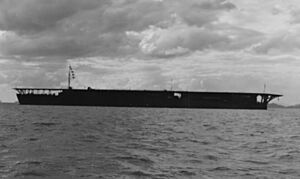
The first aircraft carrier designed from the start to be a carrier was HMS Hermes, started in 1918. Japan began work on Hōshō the next year. Hōshō was finished and ready for service in December 1922, making it the first purpose-built carrier to be commissioned. Hermes followed in February 1924.
HMS Hermes (1924): The First Island Control Tower
Even though Hōshō was finished first, the design of HMS Hermes (1924) came earlier and influenced it. Hermes was the first aircraft carrier to have two key features of modern carriers: a full-length flight deck and a control tower, called an "island," placed on the side (starboard). This design became the standard for most aircraft carriers for the next 100 years.
Hurricane Bow
A "hurricane bow" is a ship's front (bow) that is completely sealed up to the flight deck. This design was first seen on HMS Hermes (1924). It proved to be the best design for the front of a carrier.
Big Changes Before and During World War II
By the late 1930s, carriers usually carried three types of planes:
- Torpedo bombers: Used for bombing and scouting.
- Dive bombers: Also used for scouting.
- Fighters: For defending the fleet and escorting bombers.
These planes were small, had one engine, and often had folding wings to save space on the ship. The British also developed the idea of an armored flight deck, which protected the hangar below. HMS Illustrious, finished in 1940, was the first of this type.
Light Aircraft Carriers
Before World War II, President Franklin D. Roosevelt suggested turning some cruiser hulls into aircraft carriers. These "light aircraft carriers" (CVL) were faster than escort carriers and could keep up with the main fleet.
Escort Carriers and Merchant Aircraft Carriers
To protect convoys (groups of ships) in the Atlantic, the British created Merchant Aircraft Carriers. These were merchant ships with a flat deck for about six aircraft. They still carried cargo and had civilian crews, but also provided air support.
These were a temporary solution until dedicated escort carriers (CVE) could be built. Escort carriers were about one-third the size of fleet carriers and carried 20-30 aircraft, mostly for hunting submarines. Over 100 were built or converted from merchant ships. They were also used to transport aircraft across oceans. Some even fought in battles, like the Battle off Samar where a few escort carriers bravely faced much larger Japanese battleships and tricked them into retreating.
Catapult Aircraft Merchantmen (CAM Ships)
As an emergency measure, the British also used Catapult Aircraft Merchantmen (CAM ships). These were merchant ships with a catapult that could launch a single fighter plane, usually a Hawker Hurricane. Once launched, the plane couldn't land back on the ship and had to ditch in the sea if it couldn't reach land. These ships were rarely used for combat launches but did have some success.
Aircraft Carriers in World War II
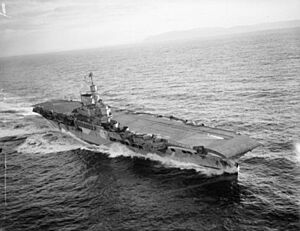
Aircraft carriers played a huge role in World War II. At the start of the war, the British Royal Navy had the most carriers. However, early in the war, the sinking of HMS Glorious by German battlecruisers showed that carriers could be vulnerable to traditional warships if they got too close.
In November 1940, HMS Illustrious launched a long-range attack on the Italian fleet at Taranto. This attack crippled three Italian battleships and showed how powerful carrier-based air strikes could be. Carriers also helped defend Malta by delivering planes and protecting supply convoys.
In the Atlantic, planes from HMS Ark Royal and HMS Victorious helped slow down the German battleship Bismarck in May 1941. Later, escort carriers were vital for protecting convoys crossing the Atlantic and Arctic.
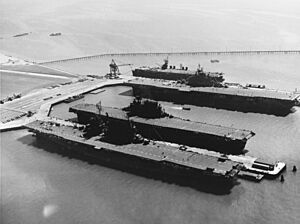
World War II in the Pacific Ocean was largely fought by aircraft carrier fleets. Japan started the war with the largest and most modern carrier fleet. The 1941 Japanese attack on Pearl Harbor by six carriers showed the immense power of a large carrier force.
The sinking of two British battleships, Prince of Wales and Repulse, by Japanese land-based aircraft in December 1941 proved that aircraft, and the ships that carried them, would now rule the seas. For the first time, planes had sunk a moving, fighting battleship.
The Battle of Midway in 1942 was a turning point in the Pacific War. It was the first naval battle decided entirely by aircraft, not by ships firing at each other. American planes sank all four Japanese carriers involved, while the US lost one carrier.
After Midway, the US built many new carriers, especially the Essex-class. These ships formed powerful "fast carrier task forces" that played a major part in winning the Pacific War. The Battle of the Philippine Sea in 1944 was the largest aircraft carrier battle ever.
The era of the battleship ended when US carrier planes sank the largest battleships ever built, the Japanese super battleships Musashi in 1944 and Yamato in 1945. Japan also built the largest aircraft carrier of the war, Shinano, converted from a Yamato-class battleship. However, it was sunk by a US submarine shortly after being finished.
Unusual carriers were also created during the war. CAM ships could launch a single fighter but not recover it. Merchant aircraft carriers (MACs) were cargo ships with a flight deck. Submarine aircraft carriers, like the Japanese I-400-class submarines, could carry three small planes, but they weren't very successful in combat.
Modern Carrier Innovations
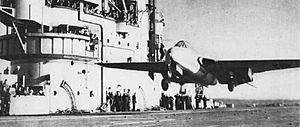
After World War II, jet aircraft became common. They were heavier and landed faster, so carriers needed big improvements.
The first jet landing on a carrier happened on December 3, 1945, when Lt Cdr Eric 'Winkle' Brown landed a de Havilland Vampire jet on HMS Ocean. He holds the record for the most carrier landings, with 2,407!
Angled Decks
During World War II, planes landed straight along the ship's length. Parked planes were at the front, behind a barrier. If a landing plane missed the arrestor wires, it could crash into the parked planes.
In the early 1950s, the British Royal Navy invented the angled flight deck. The runway was tilted a few degrees from the ship's center. If a plane missed the wires (called a "bolter"), the pilot could simply add power and take off again, flying safely over the side of the ship instead of hitting parked aircraft. This was first tested on HMS Triumph and USS Midway. USS Antietam was modified for true angled deck tests in 1952. HMS Ark Royal was the first carrier built with an angled deck from the start in 1955.
Steam Catapults
Modern steam-powered catapults were invented by Commander C.C. Mitchell of the Royal Naval Reserve. They use steam from the ship's boilers to launch planes. Trials on HMS Perseus from 1950 to 1952 showed they were more powerful and reliable than older hydraulic catapults. They were widely adopted by navies around the world.
Optical Landing Systems
Another British invention was the Optical Landing System, specifically the Mirror Landing Aid by Lieutenant Commander H. C. N. Goodhart. This system uses lights and mirrors (or later, lenses) to show pilots if they are too high, too low, or on the correct path when landing. This helped pilots land safely, especially at night or in bad weather. Before this, pilots relied on visual signals from officers on deck.
Nuclear Power
The US Navy built the first aircraft carrier powered by nuclear reactors, USS Enterprise, launched in 1961. Nuclear power allows carriers to travel for very long distances without needing to refuel, giving them almost unlimited range. Most modern US supercarriers, like the Nimitz class, use two nuclear reactors. So far, France's Charles de Gaulle is the only other nuclear-powered carrier.
Helicopters
After the war, helicopters became very important for carriers. While jets are for fighting in the air and attacking targets, helicopters are used for moving people and equipment. They are also great for hunting submarines with torpedoes and depth charges, and for attacking other ships with missiles.
Some older carriers were converted into helicopter carriers. To make them sound less expensive, new British carriers like the Invincible class were first called "through deck cruisers" and were meant to carry only helicopters. But when the Sea Harrier jet, which could take off and land vertically or with a very short run (STOVL), arrived, these ships could carry fixed-wing aircraft too.
Ski-Jump Ramp
Another British idea was the ski-jump ramp. This ramp at the end of the flight deck helps planes take off with more lift, especially STOVL aircraft like the Harrier. It allows them to carry heavier loads when taking off. Many navies, including India, Spain, Italy, Russia, and Thailand, have adopted the ski-jump for their carriers.
Carriers in Modern Conflicts
Korean War (1950-1953)
United Nations carriers began operations against North Korea in July 1950. US and British carriers, like USS Valley Forge and HMS Triumph, launched thousands of air missions. They provided air support and bombed enemy positions. Over 301,000 carrier missions were flown during the war.
Post-Colonial Conflicts
After World War II, countries like the UK and France used their carriers in conflicts as former colonies gained independence.
- France used carriers like Dixmude and Arromanches in the First Indochina War (1946–1954).
- The UK and France used carrier aircraft during the 1956 Suez Crisis. British carriers HMS Ocean and Theseus even used helicopters to land troops, which was the first large-scale helicopter assault.
Indo-Pakistan War of 1971
India used INS Vikrant against Pakistan. Its planes successfully blocked the Chittagong harbor, putting it out of action.
US Carrier Operations in Southeast Asia (Vietnam War)
From 1964 to 1973, US Navy carriers fought a long and costly war in the South China Sea. Carrier aircraft supported ground troops in South Vietnam and bombed targets in North Vietnam. At times, up to six carriers were operating at once. Hundreds of aircraft were lost, and many sailors died in combat or accidents.
Falklands War (1982)
During the Falklands War, the United Kingdom won a conflict 8,000 miles (13,000 km) from home largely because of its carriers, HMS Hermes and HMS Invincible. The Hawker Siddeley Harrier STOVL jets from these carriers were crucial for defending the fleet and attacking the enemy. Sea Harriers shot down 21 enemy jets without any losses in air combat. Helicopters from the carriers moved troops, rescued people, and hunted submarines.
The war also showed that large warships were vulnerable to nuclear submarines. The sinking of the Argentine cruiser General Belgrano by a British submarine led Argentina to withdraw its aircraft carrier.
Operations in the Persian Gulf
The US has used carriers in the Persian Gulf and Afghanistan to protect its interests. During the 2003 invasion of Iraq, US aircraft carriers were the main base for American air power. Even without many land bases, carriers allowed the US to launch significant air attacks. More recently, carriers like Ronald Reagan have provided air support for operations in Iraq.
Key Carrier Technologies
| Feature | First Seen | First Carrier | Year |
|---|---|---|---|
| Flight takeoff deck | 1910 | HMS Repulse (1916) | 1917 |
| Full-length flight deck | 1918 | HMS Argus (I49) | 1918 |
| Angled flight deck | 1948 | USS Antietam (CV-36) | 1952 |
| Aircraft elevators | 1918 | HMS Argus (I49) | 1918 |
| Purpose-built carrier | 1918 | IJN Hōshō | 1922 |
| Arresting gear | 1911 | HMS Argus (I49) | 1918 |
| Transverse arrestor gear | 1922 | Béarn | 1927 |
| Hydraulic Arrestor Gear | 1927 | Béarn | 1927 |
| Starboard Island | 1924 | HMS Hermes (95) | 1924 |
| Hurricane Bow | 1924 | HMS Hermes (95) | 1924 |
| Aircraft catapult | 1915 | USS Langley (CV 1) | 1922 |
| Steam Catapult | 1950 | HMS Ark Royal (R09) | 1955 |
| Jet Aviation | 1945 | USS Saipan (CVL-48) | 1948 |
| Optical landing system | 1953 | HMS Ark Royal (R09) | 1955 |
| Nuclear marine propulsion | 1961 | USS Enterprise (CVN-65) | 1961 |
| Ski-jump | 1973 | HMS Invincible (R05) | 1977 |
| EMALS | 2010 | USS Gerald R. Ford (CVN-78) | 2017 |
See also
 In Spanish: Historia de los portaviones para niños
In Spanish: Historia de los portaviones para niños
- Modern United States Navy carrier air operations
- Project Habakkuk
- Seadrome
Types of Ships That Carry Aircraft
- ASW carrier
- Escort carrier
- Helicopter carrier
- Light aircraft carrier
- Supercarrier
- Amphibious assault ship
- Seaplane tender
- Balloon carrier
- Submarine aircraft carrier
Related Lists
- List of aircraft carriers
- List of aircraft carriers by country
- List of aircraft carriers by type
- List of aircraft carrier classes of the United States Navy
- List of aircraft carriers in service
- Timeline for aircraft carrier service
- List of amphibious warfare ships
|


